Biography
Interests
Danyshchuk, A. T.
Vasyl Stefanyk Precarpathian National University, Department of physical therapy, ergotherapy, Ukraine
*Correspondence to: Dr. Danyshchuk, A. T., Vasyl Stefanyk Precarpathian National University, Department of physical therapy, ergotherapy, Ukraine.
Copyright © 2019 Dr. Danyshchuk, A. T. This is an open access article distributed under the Creative Commons Attribution License, which permits unrestricted use, distribution, and reproduction in any medium, provided the original work is properly cited.
Abstract
The aim of the work is to determine the degree of imbalance under the influence of submaximal
aerobic exercise on posturally significant muscles of the lower extremities in athletes 7-14 years old
with flat-footedness.
The influence of submaximal aerobic load on the lower limbs on the stability of the vertical posture
of athletes taekwon-do at the age of 7-14 years with flat-footedness of the І-ІІ degree (n = 25) and
without violation of the arches of the foot (n = 25) was studied. The regulation of the vertical posture
was investigated using the complex for the study of the functional abilities of the musculoskeletal
system “DIERS FAMUS” (“Germany”).
It is shown that physical activity increases the linear velocity of the oscillations of the pressure center in both groups. The recovery period of vertical posture stability was less in the group of
young athletes with no flatfoot signs. After exercise on one leg, the period of reduced stability of
the vertical posture was longer for young athletes with flat-footedness than in the control group:
3 minutes compared to the control group - 1 minute 50 seconds after exercise. The stability of the
vertical posture in athletes with flat feet was on average lower than in athletes without violating the
arches of the foot.
Regulation of the vertical posture of young athletes taekwon-up with flat-footedness under the
influence of physical stress worsens to a greater extent than those of their peers without signs of
violation of the arch of the foot, which is associated with asymmetry of the tone of the shin muscles
belonging to different myo-fascial kinematic chains. Specific training in the taekwon-do exercises
improves the system of postural regulation and increases the speed of its recovery after exercise in
young athletes with flat-footedness.
Introduction
Maintaining balance in a vertical posture, under normal conditions, is mainly due to the regulation of the
tone of the muscles of the legs, torso and neck, the contribution of the muscles of the shoulder girdle to this
system is less significant [1]. The equilibrium function can be significantly impaired under the influence of
the general [2] and local [3] physical load on posturally significant muscles, which is especially important
for athletes. One of the main reasons for the decline in balance after exercise is physical fatigue. Fatigue can
alter both peripheral proprioceptive sensitivity and central integration of sensory information, as well as the
generation of muscle tension [4,5]. Thus, physical fatigue is important in regulating the equilibrium function
in athletes, however, the magnitude of the changes and the rate of recovery of changes in the equilibrium
indices after the same physical load on the muscles involved and not participating in maintaining balance
remain little studied.
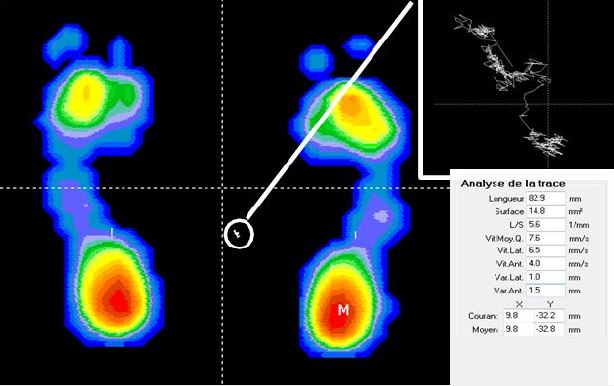
Athletes were asked to stand still in the main stand on the stabilometric platform for 6 minutes in the mode: 10 s - “test” closed eyes (CE) and 10 s - “rest”: open eyes (OE). For the analysis used the linear average speed (LAS) fluctuations in the center of pressure in the rack with CE. Previously, they trained to stand in this mode for 6 minutes for the effect of learning, reducing the impact of novelty, and for determining the conditional individual norm of stabilometric indicators. The results of the last 10 s in the “test” mode of the 6-minute test were taken as the individual norm. The visual target - the white circle - was located at a distance of 1.5m from the patient at eye level. Exercise was given to “postural” muscles (bicycle ergometry). The subjects performed a stepwise increasing load on the Kettler bicycle ergometer (Germany) until the heart rate at the end of the stage reached 170 beats / min. The heart rate during operation (at 59-60 from each stage) was recorded using a POLAR S180 heart rate monitor (Finland). The load on the first stage was 50W (duration 2 min) and increased by 30W on subsequent steps with a duration of 2 min. The load mode was chosen so that the duration of the tests was the same (9-12 min). At the end of the last stage, the subjects immediately got up on the stabiloplatform, tested the equilibrium for 6 minutes in a similar mode, 10 s - “test”: CE, 10 s - “rest”: OE.
The next series of studies was carried out while lifting the body to the “toe” on the leg with more pronounced flat-footedness. After that, stabilography was performed according to the above-described protocol.
Differences in the degree of change in performance after the PWC170 test between groups were determined using ANOVA for repeated measurements in the Statistica 6 program.
The LAS of oscillation of the center of pressure is a fairly reliable parameter reflecting the stability of
the vertical posture and the degree of stress of the equilibrium regulation function [5]. Prior to physical
exertion, LSS did not differ between EG and CG. Elevated values of LSS in both groups immediately after
submaximal load indicates a decrease in the stability of equilibrium under the influence of physical fatigue
that develops in the muscles of the leg, which belong to the postural muscle group (Fig. 2).
The degree of increase in LSS in the groups after the load was the same, however, the duration of recovery of the stability of the vertical posture was significantly shorter for athletes of the CG (within 1 min) than in the exhaust gas (for 3 min 30 s). During the entire test, in general, athletes’ MG LAS was significantly higher than in the CG (p <0.05), which is consistent with other previously published data [6].
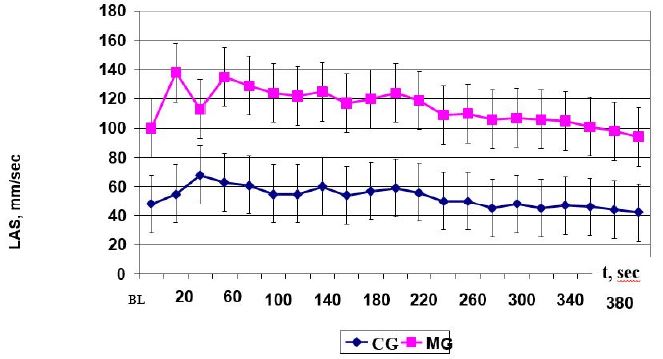
Ergometry with one foot also caused a significant increase in LAS immediately after exercise (Fig. 3).
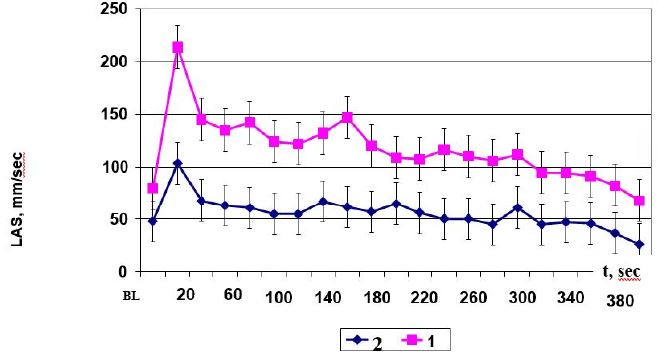
Comparing the LAS values immediately after working with two legs on a bicycle ergometer and one foot when performing the “lifting to toe” exercise to failure, we can say that the degree of increase in this parameter after submaximal work was the same in both groups.
However, the recovery rate when working with one foot was significantly lower in the MG than in the CG. The period of elevated values of LAS in the MG after the load was 3 minutes after working with the legs and 4 minutes and 15 seconds after working on one leg. Thus, it can be concluded that submaximal aerobic exercise on both legs and one leg causes a decrease in the stability of the vertical posture approximately equally in each group separately.
At the same time, a comparative intergroup analysis showed that CG athletes have the best performance in terms of both LAS and recovery time after testing general endurance. Comparison of the period of recovery of postural stability after submaximal load on one leg in athletes MG with a CG showed (Fig. 4) that at the CG it is much shorter (20 s) than in the MG (1 min 40 s).
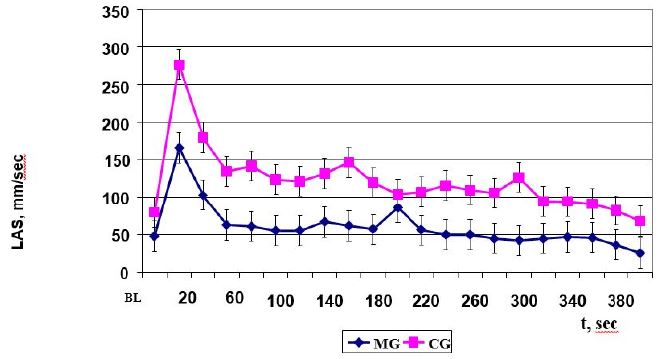
The fact of imbalance after submaximal load is associated with the development of peripheral fatigue [2- 6], and with increased activity of the cardio-respiratory system [7]. Violation of the stability of the vertical posture after the load on different muscle groups can be caused by both general mechanisms and specific ones related to the functional purpose of the muscles.
The general mechanism is probably due to the increased work of the respiratory muscles immediately after work [7], which causes an increase in body vibrations, as well as the possible general localization of fatigue in the central nervous system when working with one and two legs [8].
Also, we believe that peripheral fatigue in any muscle regions affects the central integration and analysis of incoming sensory information, which leads to a decrease in the stability of the vertical posture.
The specific mechanisms of fatigue are probably associated with the accumulation of metabolic factors of fatigue in the working muscles, which violates the sensitivity of the proprioceptive system in these muscles and, in general, postural regulation [3,4].
Explaining the decrease in the stability of the vertical posture after exertion on one leg, it should be noted that we probably could not completely eliminate fatigue in postural muscles, for example, neck and back muscles when working with one leg, because they still participated in the work and involved in maintaining balance. Consequently, part of the imbalance after exertion on one leg is also due to fatigue in postural muscles located in the upstream part of the body.
This is confirmed by electromyography data, according to which young athletes of exhaust gases experience an imbalance of electrical excitability in the muscles belonging to different myo-fascial kinematic chains within the same kinematic segment of the human body, in our case it is the calf muscles (Fig. 5).
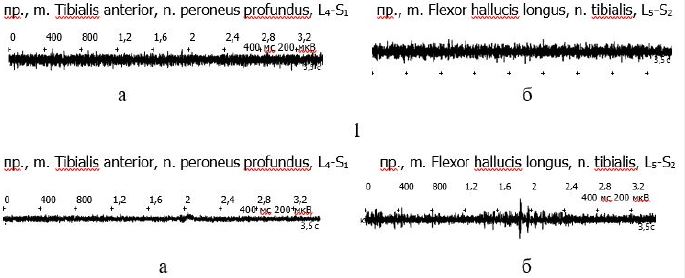
The athlete CG electrophysiological activity in both muscles is the same, because the frequency-amplitude characteristics do not have a difference between the muscles of the anterior and posterior myo-fascial kinematic chain (see. Fig. 5.1 a, b). Conversely, in the MG athlete, there is not only a decrease in the total activity in both muscles, but also an imbalance in muscle activity between the anterior (see Fig. 5. 2 a) and back (see Fig. 5. 2) myo-fascial kinematic chain.
Such an imbalance, according to some authors [3], can serve as a foundation for the violation of the CAC and the development of flatfoot.
Conclusion
Thus, after the standard intensity of submaximal load, both on one and on two legs, the stability of the
vertical posture of young athletes with flat-footedness decreases to the same extent, regardless of the degree
of their participation in the postural system, however, the recovery time for stability of the vertical posture
is less after work on the bicycle ergometer. The recovery rate of postural stability impairment in athletes
taekwon- up without disturbing the foot apparatus after a load on a bicycle ergometer is 4 times, and after
working on one leg more than three times higher than that of young athletes with flat- footedness.
Such studies are of practical importance, because in different sports, simulators are used for endurance training. Therefore, knowledge of the laws of recovery of the body will allow them to be taken into account when planning training modes.
A call for future research. The following studies will be devoted to determining the possibility of correction of flatfoot taekwon-up exercises.
Conflict of Interest
The authors state that there is no conflict of interest.
Bibliography

Hi!
We're here to answer your questions!
Send us a message via Whatsapp, and we'll reply the moment we're available!